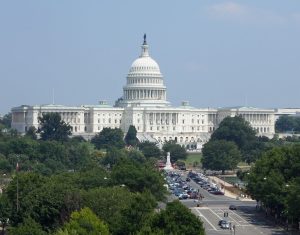
With the 2022 midterm elections only weeks away, and the 2024 presidential election quickly approaching, the current United States Congress has been working on reforming a law that was thrust into the spotlight in recent years. The 1887 Electoral Count Act was designed in response to two contested presidential elections, and set out to make clear both when and where Congress would convene to count electoral votes and the guidelines on how members of Congress could object to the count. Though the statute has been questioned by election experts since its ratification, due to a lack of clear guidance for certain circumstances and it containing language incongruent with the U.S. Constitution, the law remained largely uncontroversial for quite some time.
It is only in recent U.S. electoral history that the 1887 act became the center of more national conversations, as a handful of presidential elections saw members of Congress object to state electors. These objections, though notable, did not draw the same attention to the law as the 2021 transition of power to President Biden. In 2021, former President Trump, citing the Electoral Count Act, pressured then-Vice President Pence to reject electors from key battleground states. Pence refused to do so, and on January 6th, the day the Electoral Count Act specifics as when Congress shall convene to count electoral votes, the U.S. and the world witnessed a violent insurrection at the Capitol building.
Since that day in January, 2021, federal lawmakers have been discussing ways to update the statute to do away with the ambiguity of the process and ensure that elections cannot be stopped or overturned by any single member of Congress. On September 22, 2022, the House of Representatives passed The Presidential Election Reform Act, to update the 1887 law. The Senate has its own bill designed to revamp the Electoral Count Act, but has yet to vote on the measure. If the Senate’s bill passes, then both Chambers will convene to reconcile their bills; while they both aim for the same general goals, each bill seeks to find solutions through different mechanisms. Though many differences can be found between the two bills, each bill has a number of items in common, including: clarifying Congress’s role in ratifying states’ electoral college votes; the vice president’s role in the vote counting process; and striking pre-existing language that allows state legislatures the ability to override the popular vote in the event of an undefined “failed election”. Each bill also lays out rules designed to prohibit state legislators from altering procedures after Election Day to benefit one candidate.
The likelihood of an updated version of the Electoral Count Act, with growing momentum in both houses of Congress and with the general public’s concerns about election integrity, seems high. The questions, for the moment, seem to be whether the functions of the new law will more align with the vision set out by the House of Representatives, or those within the Senate.
This week’s Current Events resources take a look at the Electoral Count Act and the efforts surrounding updating the law. The resources shared provide context and information about the ECA, attempts to update the election protocols and the electoral collage.
Essential Questions, Vocabulary & Extend the Resources:
- What is the Electoral Count Act?
- What are the differences and similarities between the U.S. House version and the U.S. Senate version of the updated Electoral Count Bill?
- What are the arguments in favor of revamping the Electoral Count Bill?
- Is the Constitution clear on how federal elections are supposed to be counted and certified?
- In your opinion, is renewing the Electoral Count Act necessary? Explain.
- In your opinion, which bill, the House’s or Senate’s, is the superior bill? Explain.
Click here for a hardcopy of the Essential Questions & Electoral Count Act Vocabulary
Click here for a hardcopy of Extension Activities CLP suggests implementing with this content
Videos:
Podcasts:
The Case for Reforming the Electoral Count Act, We the People, Center for Civics Education, January 14, 2022
The Senate’s Proposal for Electoral Count Act Reform, The Lawfare Podcast, July 22, 2022
Unpacking bipartisan efforts to reform the Electoral Count Act, On Point, NPR, July 29, 2022
Fixing the Electoral Count Act to Stop Future Stolen Elections, Election Law Blog, September 1, 2022
Background Resources:
- 3 U.S. Code § 15 – Counting electoral votes in Congress, Cornell Law School, U.S. Code
- Electoral Count Reform Act of 2022, Senator Susan Collins, Maine
- Electoral Count Act, Protect Democracy
Recent Articles:
- Bills would curtail objections at future Jan. 6 vote counts, Yahoo!News, September 25, 2022
- Poll: Senate’s election reform bill more popular than House version, Los Angeles Times, September 23, 2022
- House Passes Overhaul of Electoral Count, Moving to Avert Another Jan. 6 Crisis, New York Times, September 21, 2022
- House Rules Committee meets to debate Presidential Electoral Reform Act, PBS, September 20, 2022
Recent Editorials:
- The Democratic plan to avert a 2024 Trump coup quietly advances, The Washington Post, September 19, 2022
- The Electoral Count Act won’t restore confidence in democracy if it’s partisan, Washington Examiner, September 16, 2022
- House Democrats Better Take the Final Chance to Fix the Law That Led to Jan. 6, New York Magazine, Intelligencer, September 20, 2022
Lesson Plans:
- Proposed Changes to the Electoral Count Act, C-SPAN Classroom
- Bell Ringer: How Electoral Votes Are Counted, C-SPAN Classroom
- The Electoral Process, iCivics
- Electoral College, Academy 4 Social Change
- The Electoral College, Elections 101, Secretary of State of Iowa
Lesson Plans for Younger Students:
- Election and Electoral College, Studies Weekly
- What is an Election?, Secretary of State of Washington




